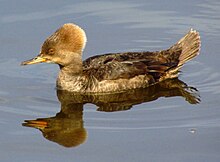Lophodytes
| Hooded merganser | |
|---|---|
 |
|
| Male | |
 |
|
| Female | |
| Scientific classification | |
| Kingdom: | Animalia |
| Phylum: | Chordata |
| Class: | Aves |
| Order: | Anseriformes |
| Family: | Anatidae |
| Subfamily: | Merginae |
| Genus: |
Lophodytes L. Reichenbach, 1853 |
| Species: | L. cucullatus |
| Binomial name | |
|
Lophodytes cucullatus (Linnaeus, 1758) |
|
| Synonyms | |
|
Mergus cucullatus |
|
Mergus cucullatus
The hooded merganser (Lophodytes cucullatus) is a species of small duck. It is the only extant species in the genus Lophodytes. The bird is striking in appearance; both sexes have crests that they can raise or lower, and the breeding plumage of the male is handsomely patterned and coloured. The hooded merganser has a sawbill but is not classified as a typical merganser.
Hooded mergansers are the second smallest species of merganser, with only the smew of Europe and Asia being smaller, and it also is the only merganser whose native habitat is restricted to North America.
A species of fossil duck from the of Vero Beach, Florida, was described as Querquedula floridana (a genus now included in Anas), but upon reexamination turned out to be a species closely related to the hooded merganser; it is now named Lophodytes floridanus, but the exact relationship between this bird and the modern species is unknown.
The hooded merganser was one of the many bird species originally described by Linnaeus in the landmark 1758 10th edition of his Systema Naturae, where it was given the binomial name of Mergus cucullatus.
The hooded merganser is a sexually dimorphic species. The adult female has a greyish-brown body, with a narrow white patch over the lower breast and belly. She has a light reddish-brown crest extending from the back of the head. During the nonbreeding season the male looks similar to the female, except that his eyes are yellow and the female's eyes are brown.
In breeding plumage the dorsal areas and the head, neck and breast of the mature male are mainly black with white markings; there are large white patches on either side of the crest, and they are particularly conspicuous when he raises his crest during courtship. His lower flanks are a rich reddish-brown or chestnut in colour, and the breast and undersides are more or less white, extending into white stripes across the crop and breast.
...
Wikipedia

